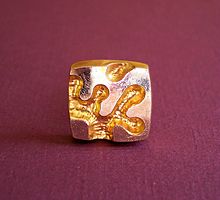Cufflink
A cufflink is used to close the cuff and is also a piece of jewelry for men. In its simplest form, a double colored silk knot with a rubber band is used as a cufflink (today mostly made entirely of rubber). Cufflinks can be made of different materials, such as: B. glass, stone, wood, leather, metal, precious metal or combinations of the above. To fasten the cuffs, toggles or the design of the backs that are leaning against the fronts and that can be folded are used. There are also variants with wire chains or with a rigid curved back. The front sides of the cufflinks can be decorated with precious stones, inlays, inlays of materials such as mother-of-pearl or enamel , and they can be designed in two or three dimensions.
History of origin
The first cufflinks appeared as early as the 17th century, but they did not come into use until the end of the 18th century. Their development is closely related to that of the men's shirt. Men have been wearing shirt-like clothing since the invention of woven fabric in the 5th millennium BC. Even if the cuts and styles changed, the basic shape always remained the same: an open tunic with sleeves and a collar. The shirt was worn next to the skin, was washable and thus protected the outer clothing from soiling through body contact. Conversely, it also protected the skin from the rougher and heavier fabrics of jackets and coats by covering the neck and wrists.
After the Middle Ages the visible portions of the shirt (the neck, wrists and Dickey) were added to a place decorative elements, such as ruffles , collars and embroidery. The cuffs were held together with ribbons, as was the collar, an early forerunner of the tie. Ruffles that fell over the wrist were worn at court and on other formal occasions until the end of the 18th century, while the sleeve of the everyday shirt of that time already ended in a simple ribbon and was closed with a button or a pair of connected buttons.
In the 19th century the old splendor of the nobility was replaced by the bourgeois efficiency of the new class of employees. From then on, men wore a very conventional wardrobe: a dark suit during the day and a tuxedo or tailcoat in the evening . The modern cuff had developed in the middle of the 19th century. Collar, shirt front and cuffs were strengthened at this time . This was popular because it emphasized the formal character of the clothing. However, the cuffs were too stiff to close with a simple button. From the middle of the 19th century, everyone who came from the middle or upper class wore cufflinks. Due to the industrial revolution , these could be mass-produced and were therefore available in every price range.
The cufflink in the 20th century

Colored cufflinks made of precious stones were initially only worn by very self-confident men. This changed when the Prince of Wales, later Edward VII , popularized colorful Fabergé cufflinks in the late 19th century . During this time, the cufflink developed into a fashionable accessory and one of the few accepted pieces of jewelry for men.
This development continued into the 1920s, when more cufflinks were worn than ever before. They were available in all shapes, colors, and materials, both in precious stones and in cheaper copies made of less precious stones and glass flux. Elaborately colored enameled cufflinks in all kinds of geometric patterns were particularly popular. All of this was equivalent, because Coco Chanel had made fashion jewelry socially acceptable. At the same time, however, a more sporty shirt style developed with unstiffened cuffs that could be closed with simple buttons. Fashion-conscious men appeared without cufflinks during the day.
This changed again after the Second World War, because the gentleman of the 1950s adorned himself with a whole ensemble of cigarette boxes, lighter, tie pins , key chains , money clips, etc., which also included massive cufflinks. The Swinging London scene of the 1960s and again brought a new male fashion consciousness appears represented by the Carnaby Street - Dandy , whose outstanding representative Mick Jagger was. Fancy cufflinks are part of a creative and eccentric men's outfit.
In the 1970s, cufflinks almost completely disappeared. Fashion was dominated by the Woodstock generation, shirts were now mainly made with ready-made buttons and buttonholes. Even after the end of the hippie era, only a few men wore cufflinks. Many heirlooms have been converted into stud earrings. Since the late 1980s, cufflinks have experienced a renaissance.
Important centers for cufflink production were Idar-Oberstein and Pforzheim . While in Idar-Oberstein cufflinks were produced from simple materials for the small budget, the Pforzheim jewelery factories produced real gold and silver in medium to high price ranges. In Pforzheim, noble cufflinks in historical and modern designs are still made using traditional craft techniques.
Nowadays, cufflinks are offered in a wide variety of models. This applies to the motif of the cufflinks, so there are not only round or square models, but also topic-related cufflinks, for example with a fire brigade, motorcycle or car motif.
They are also available in all colors and materials. Not only classic metals such as stainless steel, silver or gold are used. They are also available with mother-of-pearl, fabric, carbon, leather or wood trim.
literature
- Susan Jonas and Marilyn Nissenson: Cuff Links. Harry N. Abrams, Inc. Publishers, New York 1991, ISBN 0-8109-3168-0 .
- Bertrand Pizzin: Cuff Left. New York 2002.
- Bernhard Roetzel: The gentleman. Könemann, Cologne 1999, ISBN 3-89508-637-1 .


